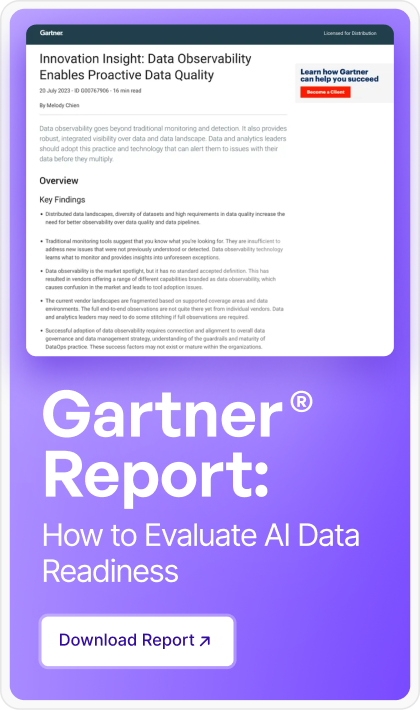Data isn't just a byproduct of business; it's also a powerful revenue driver. According to a report by the Centre for Economics and Business Research (CEBR), 80% of companies saw revenue increases after implementing real-time analytics, with a potential $2.6 trillion uplift. But leveraging data effectively requires more than just collecting it. You need visibility into and control of your data as well. That’s where data observability comes into play.
A 2023 survey by Grafana revealed that 83% of organizations with centralized observability saved time or money. In today’s competitive landscape, adopting data observability isn’t a question of if but when.
Wondering if your business is ready? Let's look at some key signs indicating that your company should invest in data observability.
1. Data Impacts the Company’s Bottom Line
When data drives your business decisions, its quality directly influences your bottom line. Whether it’s optimizing inventory, predicting customer trends, or shaping strategic moves, poor data quality can derail performance, leading to misguided decisions, lost revenue, and increased risk.
Indicators: Regular issues with stock levels, frequent discrepancies in financial forecasts, and missed opportunities due to data inaccuracies.
Solution: Adopting a data observability platform ensures real-time visibility into data quality issues, allowing for swift corrections before they impact operations. This approach helps maintain accurate stock levels, improve forecasting, and ultimately boost profitability.
Use case: Imagine a retail company that uses data to forecast demand and manage inventory. When data is inaccurate, the company faces overstocking issues, tying up cash in unsold goods, and understocking issues, leading to empty shelves and missed sales. This results in frustrated customers and lost revenue. By integrating a data observability platform, the retailer gains real-time insights into inventory levels and demand forecasts, allowing for immediate corrections. The result is a well-balanced inventory that boosts sales, optimizes cash flow, and enhances customer satisfaction.
2. Stakeholders Frequently Flag Data Quality Issues
Stakeholders, with their domain expertise, often spot data discrepancies before data teams, creating a reactive environment that hampers decision-making.
Indicators: Stakeholders flag dashboard errors, unexpected data trends, or discrepancies in reports.
Solution: Data observability platforms proactively detect anomalies and alert teams in real time, enabling them to investigate and resolve issues before they affect business outcomes.
Use case: In a financial services firm, stakeholders frequently notice errors in financial reports just before crucial meetings with investors, leading to embarrassment and loss of credibility. The reactive nature of fixing these issues disrupts the workflow and undermines trust. By implementing a data observability platform, the team receives early alerts about discrepancies before reports are finalized. This proactive approach prevents last-minute issues, boosts the firm’s credibility, and ensures a smoother presentation of accurate financial data to stakeholders.
3. Time Wasted Troubleshooting in the Dark
Data teams often waste time identifying, diagnosing, and fixing data issues without clear visibility or adequate tools. This inefficiency can result in extended downtime and wasted hours.
Indicators: Long troubleshooting times, manual investigations, and reliance on guesswork.
Solution: Data observability platforms centralize metadata and provide actionable insights, streamlining root cause analysis and improving troubleshooting efficiency.
Use case: Consider a healthcare provider dealing with delayed patient data updates across multiple systems. The data team spends countless hours manually searching for the source of errors, causing delays in patient care and risking serious consequences. With a data observability platform in place, the team quickly identifies the exact point of failure within minutes, reducing troubleshooting time from days to mere minutes. This swift resolution ensures timely and accurate patient records, improving patient care and operational efficiency.
4. Decisions Are Made on Intuition Rather Than Data
Data teams should drive strategic initiatives with actionable insights, not just react to immediate requests or rely on intuition. Relying on guesswork can lead to misaligned priorities and missed opportunities.
Indicators: Decisions based on gut feelings, prioritization of urgent issues over strategic projects, and lack of structured data management processes.
Solution: Observability tools deliver critical data insights that help teams prioritize tasks effectively, align efforts with business goals, and allocate resources confidently.
Use case: A marketing team at a tech company often makes decisions based on intuition, leading to inconsistent campaign results and wasted resources. After adopting a data observability platform, the team leverages data-driven insights to guide their strategies. This shift enables them to run targeted campaigns with higher precision, resulting in significantly improved ROI and a clearer understanding of successful marketing tactics.
5. Your Team Is Scaling Rapidly (Or Not Fast Enough)
Whether scaling up or maintaining a lean team, data observability platforms can enhance the onboarding process, reduce repetitive tasks, and empower teams.
Indicators: Difficulty onboarding new team members, skill gaps, and burnout among existing staff.
Solution: Data observability platforms reduce menial tasks, improve visibility into data infrastructure, and ensure new hires can contribute meaningfully from the start. This boosts team morale, enhances efficiency, and supports effective scaling.
Use case: A fast-growing e-commerce company struggles with onboarding new data analysts who spend weeks learning the data landscape. By implementing a data observability platform, the company provides new hires with an overview of their data infrastructure, reducing onboarding time from weeks to days. This accelerates productivity, minimizes the learning curve, and helps maintain high team performance despite rapid scaling.
Elevate Your Data Management Game
Acceldata helps businesses elevate their data management by offering a comprehensive data observability platform that optimizes data pipelines, ensures data quality, and enhances observability across the entire data infrastructure. With automated tools for monitoring, real-time alerts, and predictive insights, Acceldata enables businesses to quickly identify and resolve data issues, ensuring reliable, high-quality data for decision-making. Its advanced analytics provide a clear view of resource utilization, enabling cost optimization while maintaining performance. By simplifying complex data engineering tasks, Acceldata empowers businesses to operate more efficiently, make smarter decisions, and stay ahead in today’s data-driven world.
Discover how Acceldata can help elevate your data management game—schedule a demo today.
Summary
Recognizing the right time to adopt a data observability platform is crucial for optimizing your data management strategy. To summarize, if your data impacts your bottom line, stakeholders flag quality issues, your team struggles with troubleshooting, or decisions rely on intuition rather than data, it’s time to act. These signs highlight the need for a robust solution to enhance data quality, streamline operations, and improve decision-making.














.webp)
.webp)


